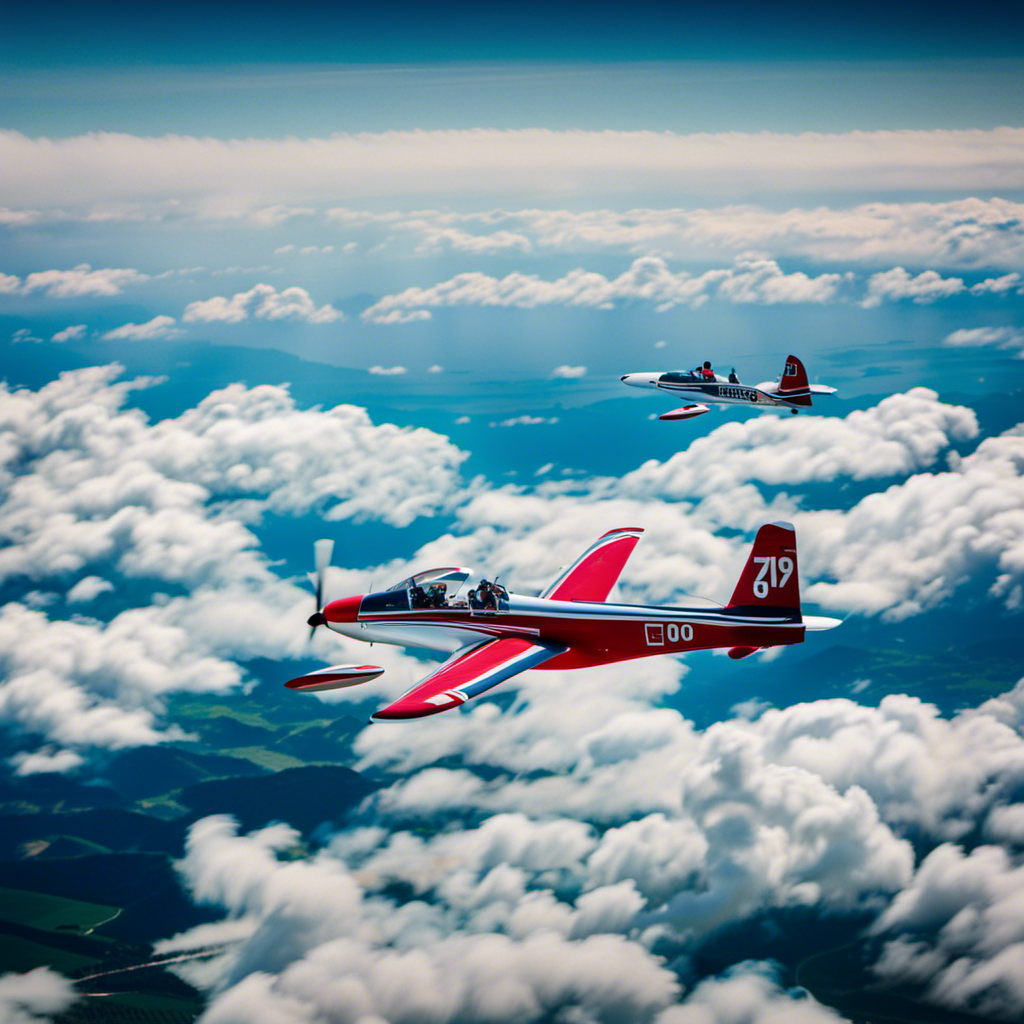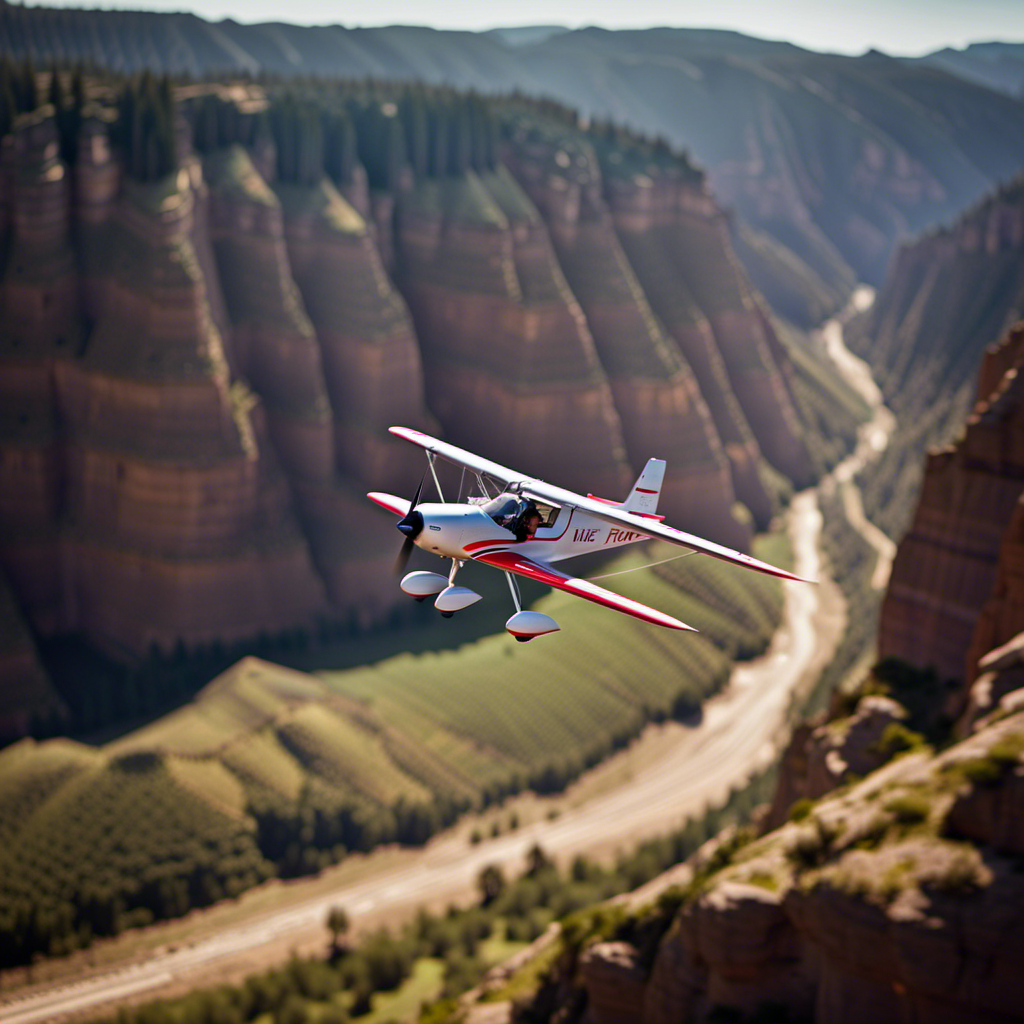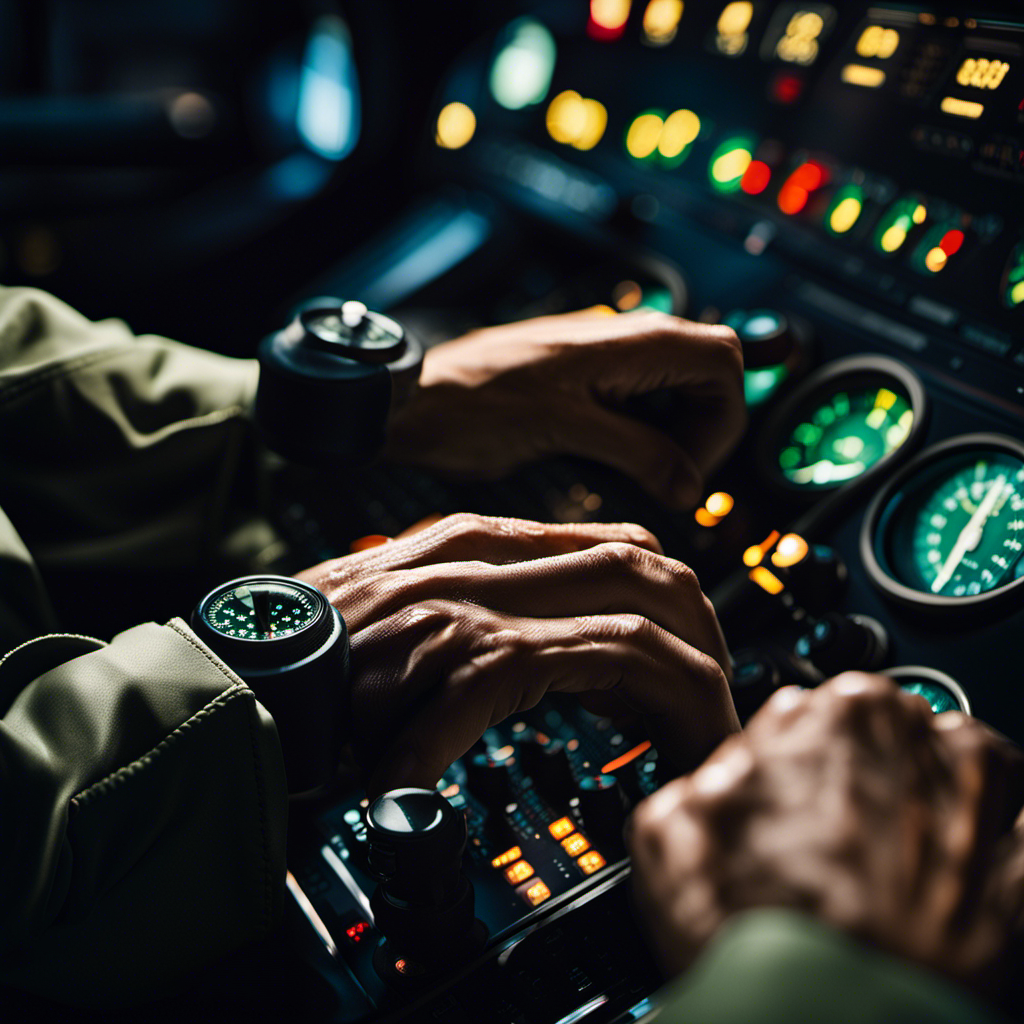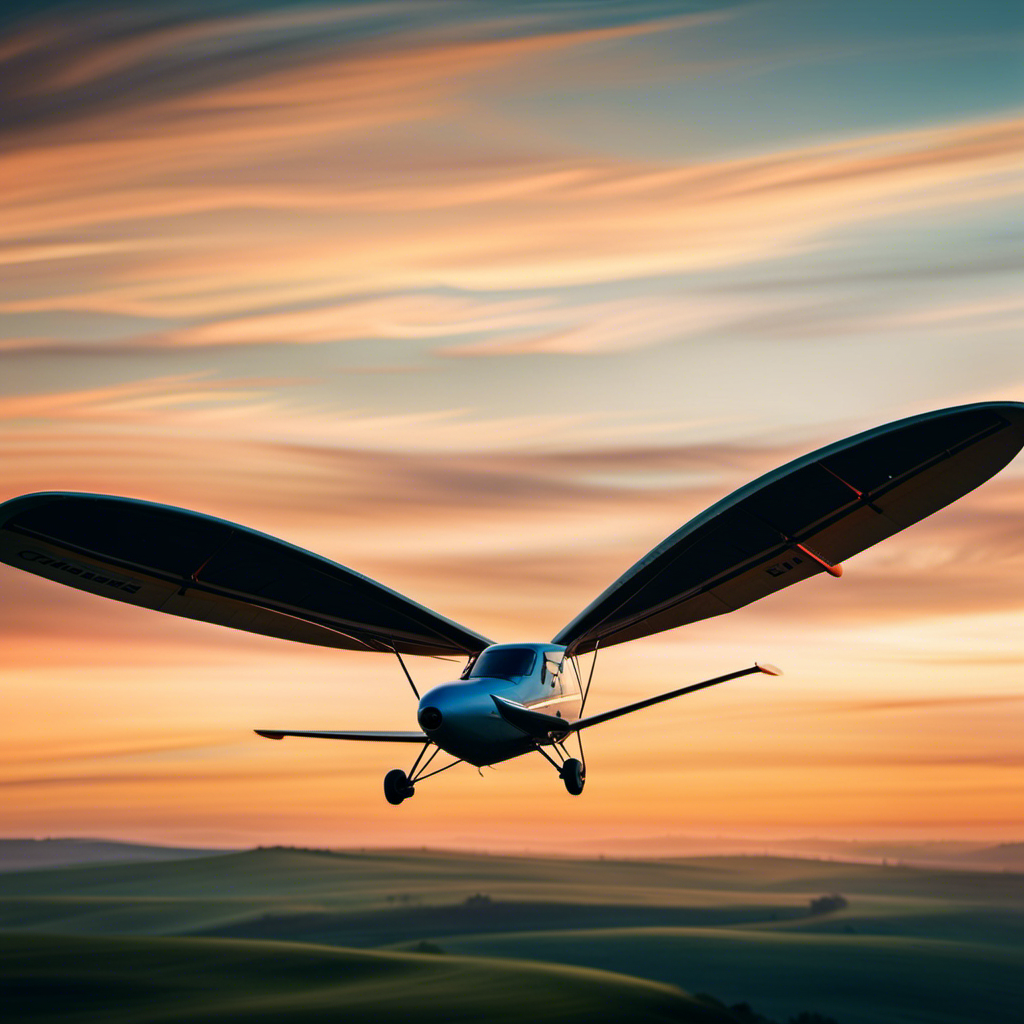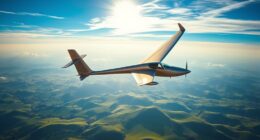Exploring the world of glider aerobatics provides an exciting experience that will leave you feeling exhilarated.
As a glider pilot, I have had the incredible opportunity to explore the exhilarating world of aerobatics. From mastering loop maneuvers to performing rolls and spins, the adrenaline rush is unmatched.
In this article, I will guide you through the basics of glider aerobatics, share safety precautions, and delve into the physics behind these gravity-defying maneuvers.
Get ready to join me on this exciting journey into the world of glider aerobatics!
Key Takeaways
- Mastering hammerhead and tailslide maneuvers requires precision, skill, and understanding of aerobatic flight techniques.
- The physics behind glider aerobatics involve lift, drag, gravity, air density, and weight distribution.
- Maintaining control and precision in glider aerobatics requires managing energy and airspeed, manipulating controls, and practicing coordinated control inputs.
- Joining a glider aerobatics club or competition allows for connecting with like-minded individuals, learning from experienced pilots, pushing skills to the next level, and experiencing the adrenaline and joy of showcasing skills in front of an audience.
Introduction to Glider Aerobatics
Are you ready to learn the basics of glider aerobatics? Strap in and get ready for an exhilarating ride into the world of glider aerobatics competitions.
Glider aerobatics is a thrilling form of aviation that combines precision, skill, and adrenaline-pumping maneuvers. Not only is it a thrilling experience, but it also offers numerous benefits for pilots who are willing to take on the challenge.
One of the biggest benefits of glider aerobatics training is the improvement of pilot skills. Maneuvering a glider through complex aerobatic sequences requires a high level of skill, coordination, and situational awareness. By practicing these maneuvers, pilots become more proficient in handling their gliders, enhancing their overall flying abilities.
Additionally, glider aerobatics competitions provide an opportunity for pilots to showcase their skills and compete against other talented aviators. These competitions are not only a test of skill but also a chance to learn from fellow pilots and gain valuable experience. The camaraderie among competitors creates a supportive and motivating environment, fostering growth and improvement.
Understanding the basics of glider aerobatics is essential for any aspiring aerobatic pilot. So let’s dive into the fundamentals, starting with the importance of safety and the key maneuvers that form the foundation of glider aerobatics.
Understanding the Basics of Glider Aerobatics
Get ready to learn the fundamentals of glider aerobatics and master the basics of this exhilarating sport. Glider aerobatics competitions are a thrilling showcase of skill and precision. Pilots navigate through a series of demanding maneuvers, performing loops, rolls, spins, and stalls with their gliders. Safety regulations in glider aerobatics play a crucial role in ensuring the well-being of the pilots and spectators.
During competitions, pilots must adhere to strict safety guidelines. These regulations include maintaining a safe altitude, ensuring proper training and certification, and using well-maintained gliders. Additionally, pilots are required to have a thorough understanding of emergency procedures and the ability to execute them swiftly and efficiently.
To compete in glider aerobatics competitions, pilots must demonstrate their proficiency and skills through a rigorous training program. This includes mastering basic aerobatic maneuvers, understanding the physics and dynamics of glider flight, and developing exceptional hand-eye coordination. Furthermore, pilots must undergo regular physical and mental fitness assessments to ensure they are capable of performing under high-pressure situations.
As we delve into the next section about safety precautions and training for glider aerobatics, it is essential to remember that success in this sport depends not only on talent but also on discipline, dedication, and a deep respect for safety regulations.
Safety Precautions and Training for Glider Aerobatics
To ensure your safety and the safety of others during glider aerobatics competitions, it is crucial to follow strict training protocols and adhere to safety precautions. Glider aerobatics requires specific equipment that meets certain requirements. Firstly, you need a well-maintained glider that is aerobatic certified. Additionally, you must have a sturdy parachute, a reliable cockpit harness, and a proper helmet to protect your head. It is important to conduct regular inspections of your equipment to ensure its functionality.
When participating in glider aerobatics, there are common mistakes that you should avoid. One common mistake is neglecting to warm up properly before flying. It is essential to perform a thorough pre-flight check to ensure that all systems are working properly. Another mistake is attempting maneuvers without proper training. It is important to receive proper instruction and practice maneuvers under the guidance of an experienced instructor.
Mastering the Loop Maneuver in Glider Aerobatics
By practicing regularly and receiving proper instruction, you’ll be able to master the loop maneuver in glider aerobatics. As a pilot, perfecting aerial maneuvers is an exhilarating journey that requires dedication and skill. Here are four key steps to help you on your way to mastering the loop maneuver:
-
Understanding the Basics: Start by familiarizing yourself with the principles of aerodynamics and the forces at play during a loop. This knowledge will provide you with a solid foundation for executing the maneuver safely and effectively.
-
Building Confidence: Begin with gentle, gradual loops, gradually increasing the size and speed as you become more comfortable. This step-by-step approach will help build your confidence and ensure a smooth progression.
-
Maintaining Control: Throughout the loop, it’s crucial to maintain precise control of the glider. Focus on smoothly coordinating your inputs and maintaining a constant speed and altitude. This will result in a well-executed loop with minimal altitude loss.
-
Perfecting the Entry and Exit: Pay close attention to the entry and exit phases of the loop. A well-executed entry sets the tone for a successful maneuver, while a smooth exit ensures a seamless transition to the next maneuver.
Exploring the Thrill of Rolls and Spins in Glider Aerobatics
Once you’ve mastered the loop maneuver, you’ll be able to experience the exhilaration of rolls and spins in glider aerobatics. These dynamic maneuvers are the next step in your glider aerobatics training and will take your flying skills to new heights. Of course, safety is of utmost importance when it comes to glider aerobatics.
Before attempting any rolls or spins, it is crucial to undergo thorough training and understand the specific techniques and precautions involved.
The benefits of glider aerobatics training extend beyond the sheer thrill of performing these maneuvers. Firstly, it greatly enhances your overall flying skills, making you a more confident and competent pilot. The precise control and coordination required for rolls and spins translate into improved handling in regular flight situations. Additionally, by pushing the boundaries of your capabilities, you develop a heightened sense of situational awareness and decision-making skills.
As you become comfortable with rolls and spins, you’ll naturally progress to learning advanced maneuvers like hammerheads and tailslides. These maneuvers further challenge your flying abilities and expand your aerobatic repertoire. With every new maneuver you master, the excitement and satisfaction of pushing your limits in the glider only grows.
Transitioning into learning advanced maneuvers like hammerheads and tailslides allows you to continue evolving as an aerobatic pilot, constantly seeking new challenges and pushing the boundaries of what you thought was possible in glider aerobatics.
Learning Advanced Maneuvers like Hammerheads and Tailslides
As you progress in your training, you’ll master advanced maneuvers like hammerheads and tailslides, taking your glider aerobatics skills to new heights. These advanced aerobatic maneuvers require precision, skill, and a deep understanding of aerobatic flight techniques. Let’s dive into the exciting world of advanced glider aerobatics.
The hammerhead maneuver is an exhilarating maneuver that involves climbing vertically until the glider loses all its forward momentum. At the top of the climb, the glider performs a half-roll, followed by a descent back to level flight. This maneuver requires precise control of the glider’s pitch and roll, as well as a keen sense of timing.
On the other hand, the tailslide maneuver is a visually stunning maneuver that involves flying the glider vertically upwards until it comes to a complete stop. The glider then slides backwards, tail first, before transitioning back to level flight. The key to executing a perfect tailslide is managing the glider’s energy and precisely controlling the elevator and rudder inputs.
Mastering these advanced aerobatic maneuvers will not only push your skills to new limits but also provide a thrilling experience like no other. Now, let’s delve into the physics behind glider aerobatics and unravel the secrets that make these maneuvers possible.
The Physics Behind Glider Aerobatics
To understand the physics behind glider aerobatics, you’ll need to grasp the concepts of lift, drag, and gravity. These fundamental forces play a crucial role in the exhilarating maneuvers performed by glider pilots.
But there are two other factors that also impact glider aerobatics: air density and weight distribution.
Air density: Glider aerobatics heavily rely on air density. As the density of the air increases, there is more resistance against the glider’s movement, making it easier to execute precise maneuvers. On the other hand, in low-density air, the glider may feel more sluggish, requiring greater control inputs to maintain stability.
Weight distribution: Proper weight distribution is vital in glider aerobatics. The distribution of weight affects the glider’s balance and maneuverability. By adjusting the weight distribution, pilots can control the glider’s response to different aerobatic movements, ensuring stability and precision.
Understanding the role of air density and weight distribution is crucial for executing flawless glider aerobatics. By manipulating these factors, pilots can achieve incredible feats of skill and grace in the sky.
As we delve further into the world of glider aerobatics, let’s explore some important tips for maintaining control and precision in these thrilling maneuvers.
Tips for Maintaining Control and Precision in Glider Aerobatics
As I delved deeper into the world of glider aerobatics, I couldn’t help but be fascinated by the intricacies of maintaining control and precision while performing thrilling maneuvers. It became apparent to me that maintaining altitude and improving coordination were crucial aspects of mastering glider aerobatics.
To maintain altitude during maneuvers, it is essential to carefully manage the glider’s energy and airspeed. By understanding the principles of aerodynamics, I learned how to manipulate the controls to generate the necessary lift and minimize drag. This allowed me to execute precise climbs, rolls, loops, and spins while keeping the glider at a consistent altitude.
Improving coordination was another key factor in achieving smooth and precise aerobatic maneuvers. I discovered that proper coordination between the rudder, ailerons, and elevator was crucial for maintaining control and stability. By practicing coordinated control inputs and developing a keen sense of timing, I was able to execute maneuvers with grace and precision.
Transitioning from maintaining control and precision, the next step in my glider aerobatics journey was joining a glider aerobatics club or competition.
Joining a Glider Aerobatics Club or Competition
After delving deeper into the world of glider aerobatics, I couldn’t resist joining a glider aerobatics club to further enhance my skills. It was an exhilarating decision that opened up a whole new world of opportunities for me. Here are a few reasons why joining a glider aerobatics club or competing in glider aerobatics events is an incredible experience:
-
Community: Being part of a glider aerobatics club allows you to connect with like-minded individuals who share the same passion for aviation and aerobatics. You get to learn from experienced pilots, exchange tips and tricks, and build lasting friendships.
-
Skill Development: Competing in glider aerobatics pushes you to constantly improve your skills and take your flying abilities to the next level. The challenges and pressure of competitions provide a unique opportunity to grow as a pilot and refine your aerobatic maneuvers.
-
Thrill of Competition: There’s nothing quite like the adrenaline rush of competing in glider aerobatics events. The feeling of being in the air, executing precise maneuvers, and showcasing your skills in front of an audience is truly electrifying.
-
Achievement and Recognition: Participating in glider aerobatics competitions gives you the chance to earn recognition for your skills and achievements. It’s incredibly rewarding to see your hard work pay off and be acknowledged among fellow pilots.
Experiencing the Adrenaline and Joy of Glider Aerobatics
Immerse yourself in the electrifying world of glider aerobatics and feel the adrenaline rush as you execute precise maneuvers in the air. Glider aerobatics is a thrilling experience that combines the beauty of flight with the excitement of performing aerial acrobatics techniques.
As a pilot, I can attest to the incredible sensation of experiencing the rush of the wind against my face as I maneuver through the sky.
One of the most exhilarating aspects of glider aerobatics is the ability to perform a variety of aerial acrobatics techniques. From loops and rolls to spins and stalls, these maneuvers require skill, precision, and a deep understanding of the aircraft’s capabilities. The feeling of executing a perfectly timed loop or a graceful roll is unmatched and brings a sense of joy and accomplishment like no other.
In addition to the adrenaline rush and joy, glider aerobatics also offers a unique perspective of the world below. As I soar through the air, I am treated to breathtaking views of the landscape, feeling a sense of freedom and liberation. The combination of the physical sensations, the technical skill, and the awe-inspiring views make glider aerobatics an experience unlike any other.
Frequently Asked Questions
Can anyone participate in glider aerobatics, or are there any specific requirements or limitations?
Anyone can participate in glider aerobatics, but there are certain participation requirements and safety precautions to consider. These may include having a valid pilot’s license, undergoing training, and following specific guidelines to ensure a safe and thrilling experience.
Are there any age restrictions for participating in glider aerobatics?
There are absolutely NO age restrictions for participating in glider aerobatics! As long as you can reach the controls and follow safety precautions, you can experience the thrill of aerobatics at any age.
How long does it typically take to become proficient in glider aerobatics?
Becoming proficient in glider aerobatics takes time and dedication. It typically takes several years of training to master the necessary skills. The benefits of glider aerobatics training include improved flying skills, increased confidence, and an exhilarating sense of freedom.
Are there any medical conditions that might prevent someone from participating in glider aerobatics?
There are certain medical conditions that may prevent individuals from participating in glider aerobatics. Safety considerations are of utmost importance, and it is crucial to consult with a doctor before engaging in such activities.
What is the cost associated with getting involved in glider aerobatics, including training and equipment?
The cost of getting involved in glider aerobatics, including training and equipment expenses, can vary depending on factors such as location and instructor fees. Training costs may range from $2,000 to $5,000, while equipment expenses can add another $3,000 to $10,000.
Conclusion
In conclusion, glider aerobatics is an exhilarating experience that pushes the boundaries of flying. Mastering maneuvers like loops, rolls, and spins requires skill, precision, and a deep understanding of the physics involved.
Safety precautions and training are essential to ensure a thrilling yet secure adventure. Maintaining control and precision is key in glider aerobatics, much like a tightrope walker balancing effortlessly on a thin wire.
So, if you’re seeking an adrenaline rush and the joy of defying gravity, glider aerobatics is the perfect adventure for you.
Orion, better known as “Jetstream,” is the voice that brings the stories of the skies to life. His fascination with aviation began at a young age, sparked by his father’s tales of flying and adventure. Orion’s journey into the world of gliding was serendipitous, and from the moment he took his first glider flight, he knew he had found his calling.
